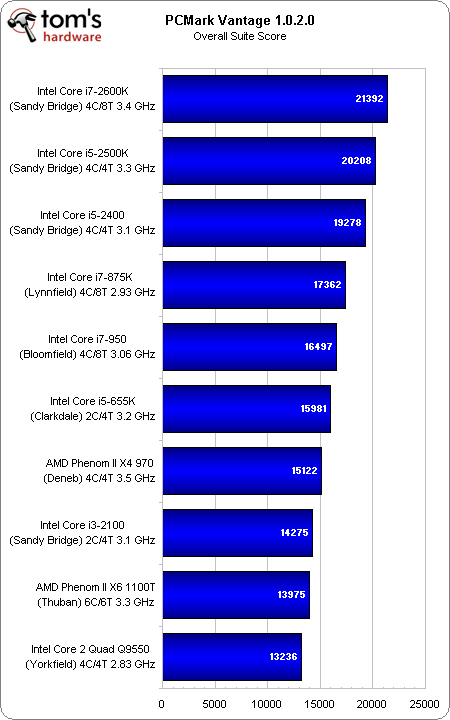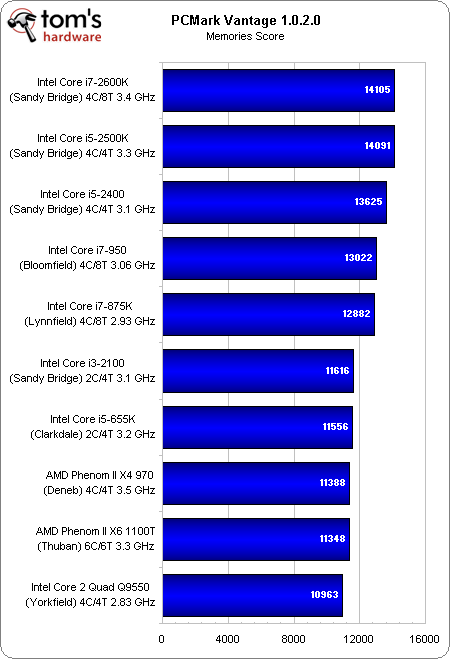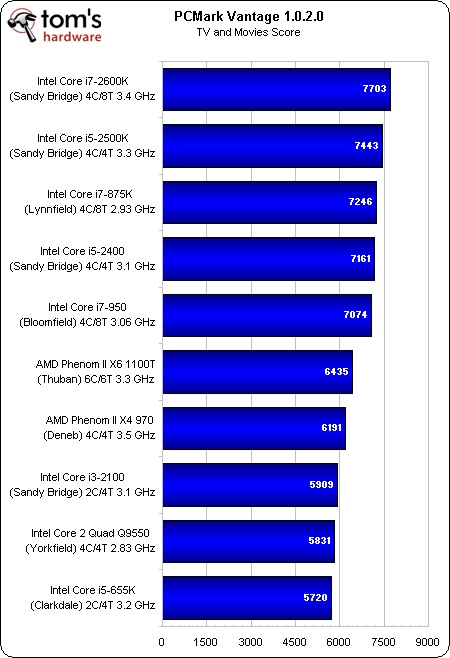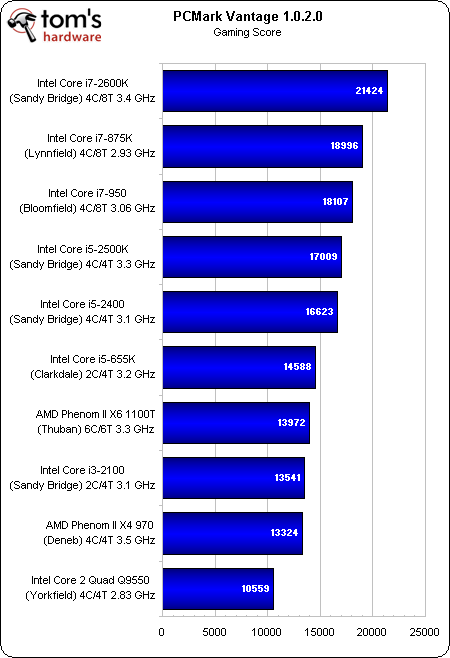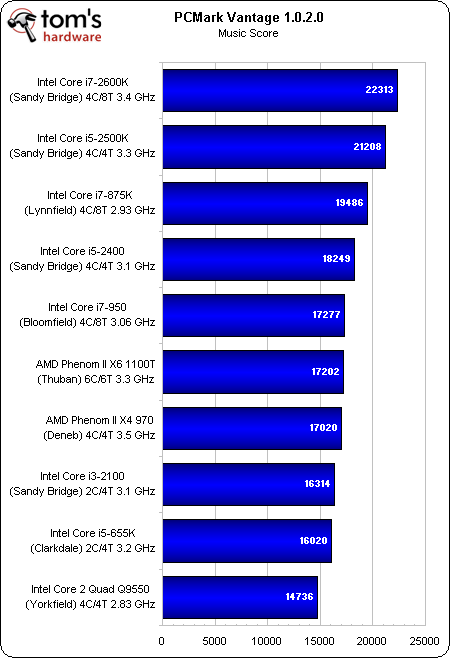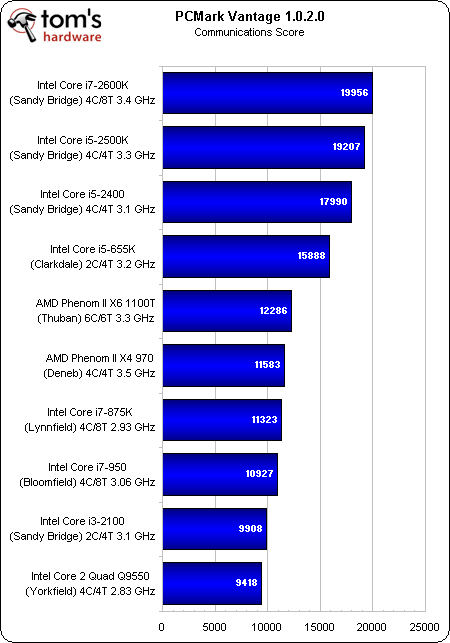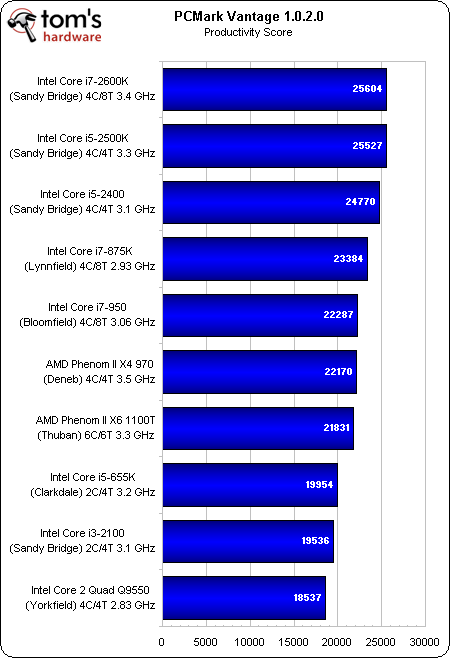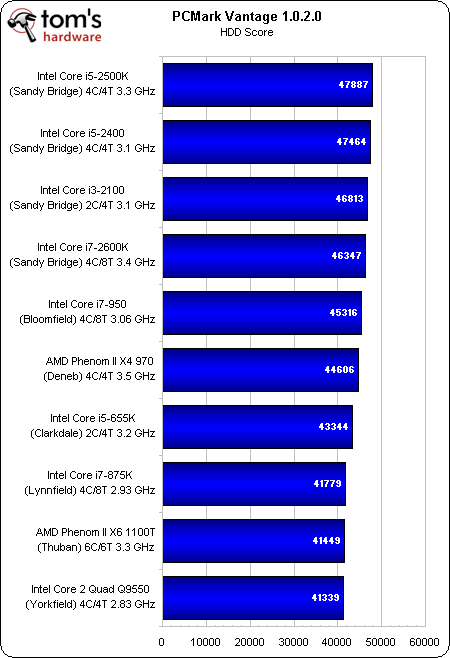Intel’s Second-Gen Core CPUs: The Sandy Bridge Review
Although the processing cores in Intel’s Sandy Bridge architecture are decidedly similar to Nehalem, the integration of on-die graphics and a ring bus improves performance for mainstream users. Intel’s Quick Sync is this design’s secret weapon, though.
Benchmark Results: PCMark Vantage
Three Sandy Bridge-based CPUs top the Overall chart, followed by the Core i7-875K, which benefits from its ability to Turbo Boost up to 3.6 GHz.
Although Intel’s Core i7-950 runs at a faster base clock rate and enjoys the throughput of a triple-channel DDR3 memory interface, its highest official memory data rate is 1066 MT/s (compared to Lynnfield’s 1333 MT/s). And it probably doesn’t help that the 900-series processor can only Boost to 3.33 GHz.
A lack of software able to fully utilize six cores and a lower base clock rate hurts AMD’s Phenom II X6 1100T overall. You do see that, in certain disciplines, like TV and Movies and Communications, the hexa-core chip’s standing improves. Meanwhile, the Phenom II X4 970 sees a comparative advantage thanks to its fixed 3.5 GHz clock rate.
This won’t be the first time I say this in my benchmark analysis: if Phenom II were living in a Core 2 world, it’d be sitting pretty. Up against Nehalem, it simply gets outclassed. Compared to Sandy Bridge, it’s just not close. But then again, PCMark Vantage is technically a synthetic. Let’s keep moving and see if more specific workloads change the story our data tells.
Get Tom's Hardware's best news and in-depth reviews, straight to your inbox.
Current page: Benchmark Results: PCMark Vantage
Prev Page Hardware Setup Next Page Benchmark Results: 3DMark11-
cangelini MoneyFace pEditor, page 10 has mistakes. Its LGA1155, not LGA1555.Reply
Fixed, thanks Money! -
juncture "an unlocked Sandy Bridge chip for $11 extra is actually pretty damn sexy."Reply
i think the author's saying he's a sexually active cyberphile -
fakie Contest is limited to residents of the USA (excluding Rhode Island) 18 years of age and older.Reply
Everytime there's a new contest, I see this line. =( -
englandr753 Great article guys. Glad to see you got your hands on those beauties. I look forward to you doing the same type of review with bulldozer. =DReply -
joytech22 Wow Intel owns when it came to converting video, beating out much faster dedicated solutions, which was strange but still awesome.Reply
I don't know how AMD's going to fare but i hope their new architecture will at least compete with these CPU's, because for a few years now AMD has been at least a generation worth of speed behind Intel.
Also Intel's IGP's are finally gaining some ground in the games department. -
cangelini fakieContest is limited to residents of the USA (excluding Rhode Island) 18 years of age and older.Everytime there's a new contest, I see this line. =(Reply
I really wish this weren't the case fakie--and I'm very sorry it is. We're unfortunately subject to the will of the finance folks and the government, who make it hard to give things away without significant tax ramifications. I know that's of little consolation, but that's the reason :(
Best,
Chris -
LuckyDucky7 "It’s the value-oriented buyers with processor budgets between $100 and $150 (where AMD offers some of its best deals) who get screwed."Reply
I believe that says it all. Sorry, Intel, your new architecture may be excellent, but unless the i3-2100 series outperforms anything AMD can offer at the same price range WHILE OVERCLOCKED, you will see none of my desktop dollars.
That is all.
